|
1.
CENTRAL/ WEST AFRICA
China and India help sustain West Africa trade
While China and India were buying at reasonable levels,
log trade elsewhere was very slow and demand was low.
Prices were reported as stable, although beyond the
restricted number of species for China and India, there
were too few buyers in the market on which to base
normal market prices. Some business in non-premium
species was being conducted with Vietnam. Prices for
these species were likely to have been keenly negotiated
and qualities would have been lower than usual.
The onset of many countries¡¯ global economic problems
has yet to fully impact all sectors of the log and lumber
industries. However, lower growth forecasts for
economies in developed countries is certain to slow
manufacturing and sales of furniture, which will impact
demand for tropical timber. There has already been a
downturn in sales of board products in Europe, due to
problems in the building industries and lower demand
from furniture manufacturers and exporters.
As with logs, it is likely that sawn lumber prices appear
stable only because of low trading volumes, rather than
being led by demand in the market. Buying was very slow
over the previous fortnight. Sapele prices were still
variable and subject to offers. Buying for iroko lumber
was weaker due to lower demand.
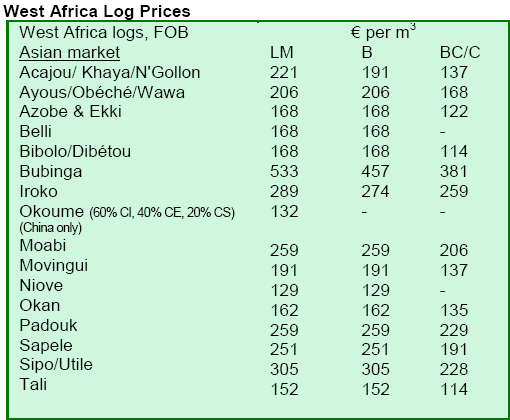
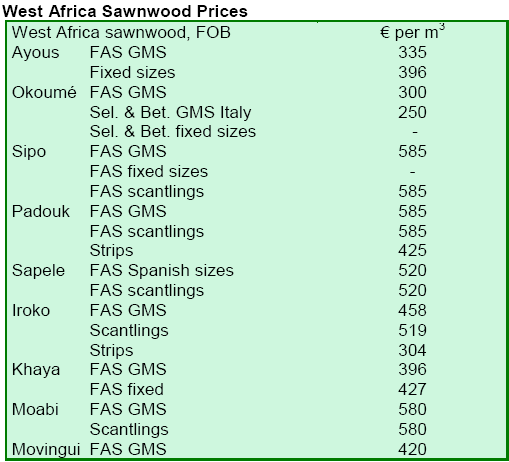
2. GHANA
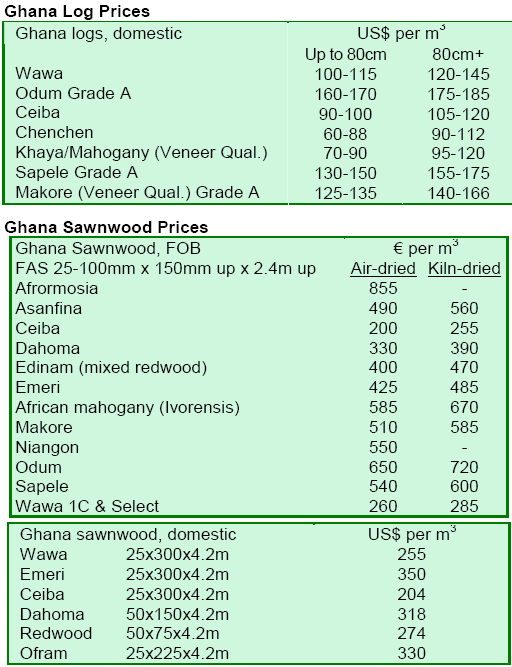
3.
MALAYSIA
Deputy Minister calls for original design manufacturing in
Malaysia
Deputy Minister of Plantation Industries and
Commodities, Mr. A. Kohilan Pillay said that Malaysian
timber companies should invest in original design
manufacturing (ODM) and own brand manufacturing
(OBM). According to Bernama News, the Deputy Minister
noted that ODM and OBM would allow Malaysian timber
companies to improve their competitive status among
other low-cost producer countries such as China and
Vietnam.
The Deputy Minister made the announcement at
Aseanwood-Woodtech Malaysia (WTM) 2008, a leading
trade show for the woodworking industry, held from 24-28
September at the Putra World Trade Center (PWTC) in
Kuala Lumpur. The show was estimated to draw over
15,000 visitors, a projected growth of 10% over the
number of visitors received during the last show in 2005.
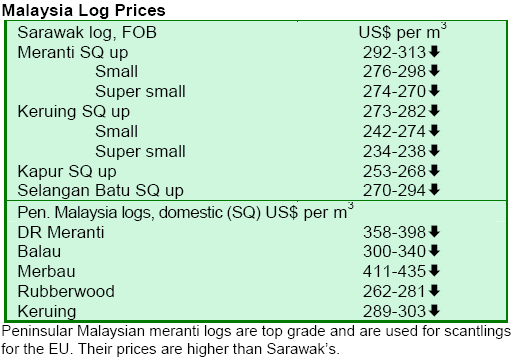
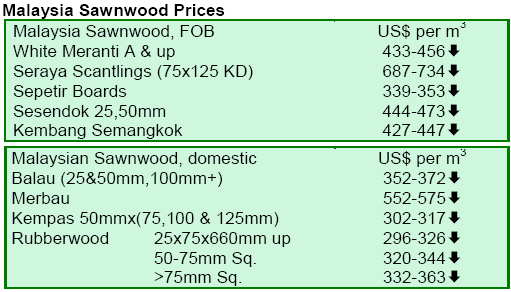
4.
INDONESIA
Indonesia to lower export growth targets for 2009
Antara News has reported that the government of
Indonesia may be revising its export growth targets for
2009, since exports are expected to decline in line with the
current financial crisis in the US. Trade Minister Mari
Elka Pangestu announced Indonesia¡¯s precautionary steps,
saying that the government must be realistic about global
economic conditions. She noted that the government needs
to also intensify export promotion campaigns to diversify
markets and export products to non-traditional export
destinations.
While widespread declining commodity prices are
affecting Indonesian exports, the fall of the Indonesian
rupiah is also drawing investors to Indonesian forest
plantations as an alternative to the receding financial
markets. With long gestation periods and carbon trading
schemes, plantation forests appear to fit in well with midterm
to long-term investments.
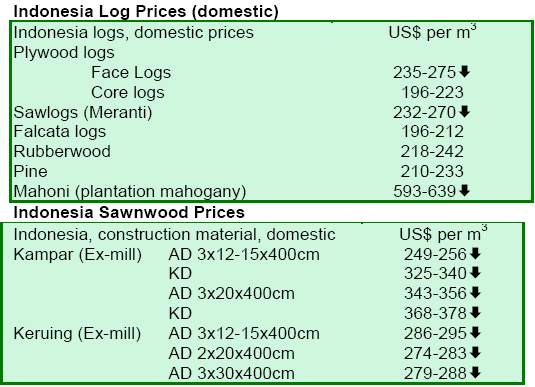
5.
MYANMAR
Teak plantations are on the rise in Myanmar
Recent news reports from Myanmar have indicated that
plantation areas have been growing in recent years,
particularly in the Pyinmana and Taungdwingyi districts
where conditions are highly suitable for growing world
class teak. The Forestry Department of the Ministry of
Forestry has planted teak on the Bago Yoma mountain
range in the Pyinmana District as part of the Ministry¡¯s
greening project of 2004-2005. Further actions under this
greening plan are being undertaken during 2008-2009 (see
TTMR 13:16).
Other reports have indicated that two privately owned teak
plantations have been established: a 5,000 acre teak
plantation in Kyangin Forest Reserve in the Ayeyarwady
area and a 1,700 acre teak plantation in Taungnawin
Forest Reserve of Paukkhaung Township. Both private
entities planted teak in deforested areas after 2006. One
owner of the forest plantations noted that he would wait
about six to seven years before harvesting the trees,
instead of maintaining the stands for about 40 years.
The government has also been conducting work to assist
others in managing and establishing plantations. The
Ministry of Forestry and the Myanmar Timber
Entrepreneurs Association (MTEA) jointly held a seminar
on 4 October in Yangon to discuss these themes.
Participants at the seminar examined the specific subjects
of timber certification and wood industry development and
identified opportunities to establish teak plantations.
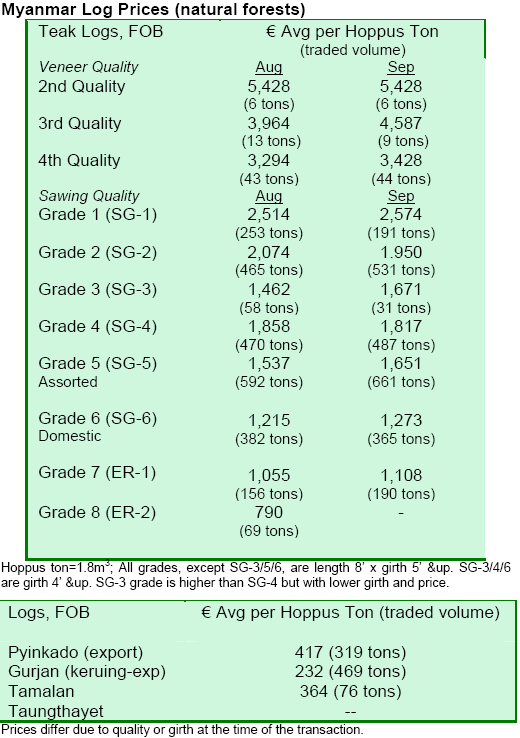
6.
BRAZIL
Forest condominiums offer new opportunities to invest
in high value wood
The Brazilian Micro and Small Enterprises Support
Service (SEBRAE) indicated that innovative forms of
investment are opening as a result of the forest sector¡¯s
expansion in Brazil. One of the newest mechanisms, called
a forest ¡®condominium¡¯, has been developed by a private
company in the state of Mato Grosso do Sul and is
expected to help establish Brazil¡¯s largest area of fully
irrigated forest plantation containing native species. The
mechanism will group individual investors, with each
investor¡¯s share relative to their investment, and establish
a private firm responsible for overseeing operations.
Guanandi (Calophyllum brasiliense), the species planted in
the new project is native, of high value and on the brink of
extinction. In the coming years, the demand and price for
high value wood will be much greater due to its scarcity
and strict environmental laws that prohibit the
indiscriminate logging in conservation areas. The system
works by offering a lease on farm lands and a services
contract for environmental management of the plantation.
The leaseholder will make an initial investment and the
management of the forest remains with the services
provider. The leaseholder will also be entitled to profits
from products, such as seeds, wood or any other resources
from the plantation.
The scheme will also apply advanced technology for forest
maintenance and tree planting. One of the new
technologies combines drip irrigation and ferti-irrigation
systems and is expected to raise productivity of the
plantations by nearly 30%. Another project using the tree
species Canafistula is expected to be conducted in the near
future and should help supply greater raw materials for
furniture manufacturing, due to the species¡¯ reduced
harvesting cycle of approximately nine years.
New research shows possibility of mahogany
reforestation
A technique developed by researchers at the Federal Rural
University of Amazonia (UFRA) could facilitate largescale
mahogany planting. Mahogany reforestation has
previously been difficult due to the caterpillar moth
Hypsipyla grandella, which causes wide-scale damage to
plantations. Sociedade Brasilera de Silvicultura has noted
that the new tree planting technique developed by the
researchers, which combines the planting of mahogany
and cedar (Toona Ciliata, an exotic species that attracts
moths) leaves the mahogany free of the pest. Another
technique that uses the substance colacid on young
populations of mahogany has also shown to be effective in
controlling the caterpillar moths.
Enabling cultivation of planted forests can help ease
pressure caused by the exploitation of mahogany in the
Amazon. According to researchers, further tests will be
conducted using the new techniques before they can be
applied to rehabilitate degraded areas. Due to its high
value in the international market, mahogany has been
heavily logged in the past and today is included on the list
of endangered species.
Timber companies dissatisfied with new procedures
for export
S¡§® Noticias/Assessoria de Imprensa reported that the
timber sector of the Northern region of state of Mato
Grosso is not satisfied with the government's new legal
procedures demanding timber export companies to
implement a new system to control of goods and products
under the Export Control System of Mato Grosso. Under
Decree 1562, which was enacted in September 2008,
exporting companies are required to register invoices for
direct export (when the company itself negotiates its
export) and indirect export (the negotiations are made
through a trading company) under the Digitalized System
of Export Invoices. In practice, although the forest
products market is active, the paperwork changed by
various decrees and administrative ordinances makes the
market negotiations slower and hinders expansion of the
market. The new bureaucratic procedures cause
inconveniences for timber companies since they need to
complete paperwork to begin their transactions or pay a
tax.
Northern Brazil¡¯s forest products sector cautious in
making projections
Remade/Celulose Online has indicated that due to the
Real¡¯s fluctuation in recent weeks, Northern Brazil¡¯s
forest products sector has taken a cautious approach to its
current projections about growing timber sales to foreign
markets. According to the Timber Traders Union of the
Far North (SIMENORTE), the municipality of Alta
Floresta has already reported a reduction in forest products
exports by volume.
With the intensification of the crisis in the Brazilian
financial market over the past few weeks, production costs
have jumped and the value of the US dollar, on which
most of Brazil¡¯s foreign timber sales are based, has fallen.
Consequently, the domestic market has been seen as a
more attractive destination for Brazil¡¯s forest products. In
the municipality of Alta Floresta alone, the bulk of its
recent trade resulted from business conducted with other
states, in addition to sales within the Alta Floresta
municipality.
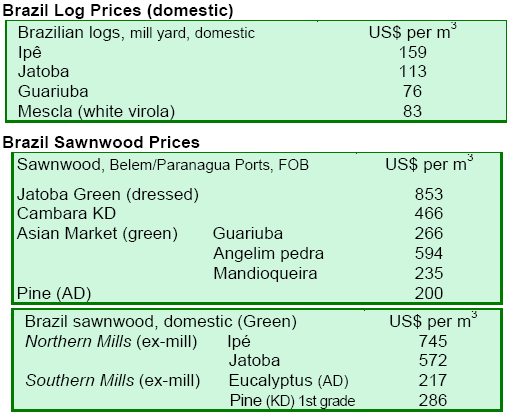
7.
PERU
Lima to host international wood fair
The Second International Fair on Machinery, Equipment
and Services (FENAFOR) for the wood sector will be held
from 16-18 October 2008 in Jockey Plaza, Lima.
Organizers have announced that the Fair will include the
participation of several foreign companies. Among the
items to be discussed will be low-impact harvesting
techniques, product processing and value-added activities.
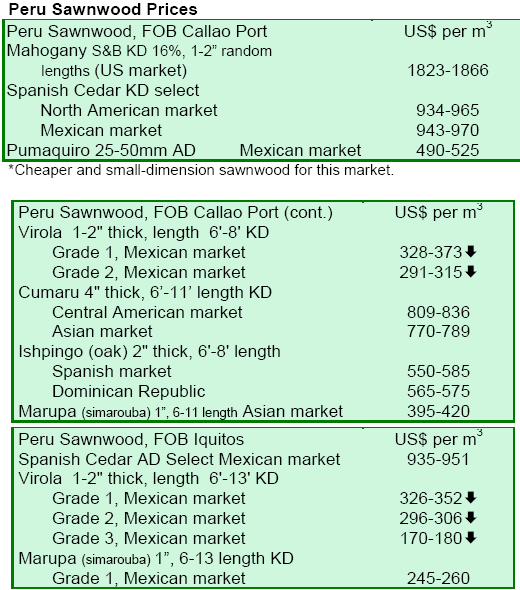
8. BOLIVIA
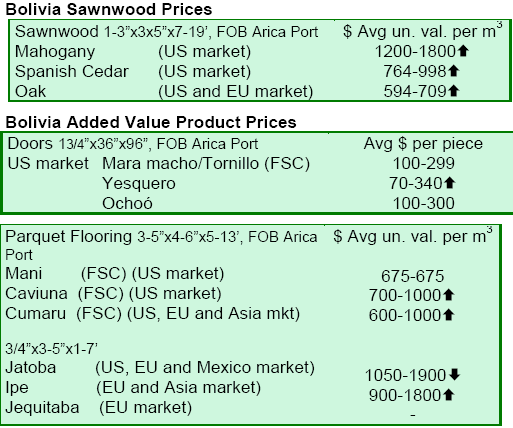
9. MEXICO
Commercial forest plantations draw further financial
support
In July, Agropecuaria Santa Genoveva S.A.P.I. announced
the use of stock-exchange certificates (CBs) to complete
the financing of a forest teak plantation in the south-east of
the country. The CBs will be established through a trust
consisting of two components: a) a guaranteed component
that ensures total recovery of the invested capital; and b) a
variable component based on the remaining resources
contributed by investors. The project has already had a
positive impact on the economic and social conditions of
the region, since it entails a high level of investment and
has been a source of work opportunities.
The instrument is the first of its kind in Mexico and is part
of the Society of Specialized Investment in Retirement
Funds (SIEFORES), which creates a bridge between the
savings of Mexican workers¡¯ savings and productive
investments in the long-term. It will facilitate funding for
long-term plantation investments and strengthen economic
activity in the region. This new investment opportunity has
been seen as an excellent alternative to other long-term
investment strategies and is expected to attract finance
from various sectors.
10.
GUYANA
Market trends stable over past fortnight
Export market prices have remained stable for most
species of logs exported in the last fortnight of September
2008. While prices for greenheart logs remained stable,
mora logs increased on average between 12% and 21% for
various grades. Prices for purpleheart logs have similarly
remained stable for the same period with marginal raises
for some grade categories.
Undressed sawnwood prices for mora have declined from
early September, when prices were at an all time high of
USD1,696 per m³. However, purpleheart undressed
sawnwood showed a reverse trend, with higher prices seen
on average for every grade exported in the last fortnight.
Domestic prices in Guyana were marginally lower for
almost all products. Dressed sawnwood, more so than
undressed sawnwood, showed a much greater difference in
the export versus the domestic price. Domestic prices have
traditionally been lower than export prices over the past
five years. Domestic prices for most products have
generally risen over the years with prices of other products
remaining stable. Table 1 below shows a summary of
domestic prices for 2007 and 2008.
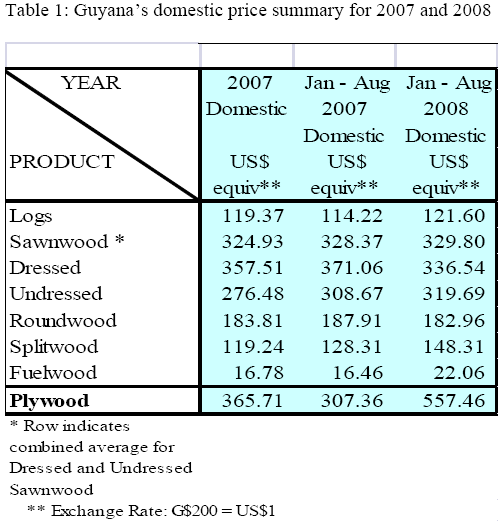
Guyana discusses potential technical assistance at
Latin American and Caribbean Forestry Commission
Guyana attended the 25th session of FAO¡¯s Latin
American and Caribbean Forestry Commission (LACFC)
in Quito, Ecuador, from 29 September to 3 October 2008.
The LACFC has been a forum in which member countries
like Guyana can strengthen regional dialogue and set
ground work necessary to implement LACFC¡¯s work plan
over coming months. The main areas of discussion at the
session were forest institutions and forest legislation,
forest and climate change and sustainable forest
management.
During the session, it was noted that over the 2006¡ª2008
period, the counties of the LAC region had continued to
implement, review and formulate their forest policies
within the framework for national forest programmes and
were sustainably building their institutional capacities.
However, it was noted that although progress had been
made, the region continues to face two major challenges:
overcoming restrictions on and introducing better
sustainable forest management procedures for natural
forests; and strengthening the prevention and control of
forest fires. As a result of the meeting, Guyana was
expected to benefit from potential technical support to
preserve Guyana¡¯s forests, including through schemes
such as the Clean Development Mechanism and Reducing
Emissions from Deforestation and Degradation.
Forestry Training Center Incorporated continues SFM
work
Aiming to meet the growing demand for improved forest
management in Guyana, the Forestry Training Center
Incorporated (FTCI), has expanded its scope of training to
include small and medium size forest operations. Since its
establishment in 2002, through a project financed by the
ITTO, the Center has regional as well as extensive
national coverage. FTCI¡¯s activities have been directed
toward on-site training as many participants, especially
those in rural-based forest communities, find it more
convenient to undertake training in community forest
areas.
Additionally, the FTCI has been providing Reduced
Impact Logging (RIL) training for students, including the
University of Guyana (UG) and the Guyana School of
Agriculture (GSA), residents of Amerindian communities
and non-governmental organizations. FTCI has established
itself as a major stakeholder in the forestry sector through
the provision of vocational education and training. During
2007, 266 persons were trained in RIL at the Center. One
hundred and fifty (150) of these were Guyanese, many of
which were from communities, while the others were
drawn from the Caribbean, Belize and Suriname. During
the first half of 2008, FTCI has trained 142 persons.
Based on consultations and discussions with stakeholders,
two training manuals have been developed to date: a
¡®Forest Roads Manual¡¯ and ¡®An Introduction to Wood
Technology¡¯. In addition to these manuals, the FTCI
continues to provide training in RIL, forestry extension
and environmental impact assessments, creating a strong
foundation for sustainable forest management in Guyana.
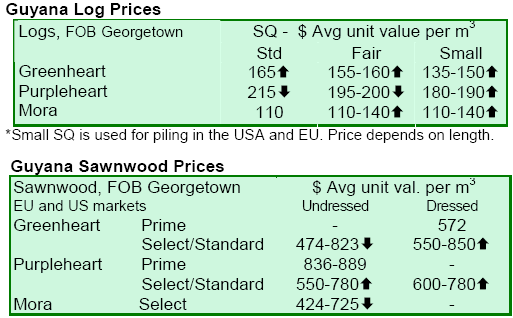
|